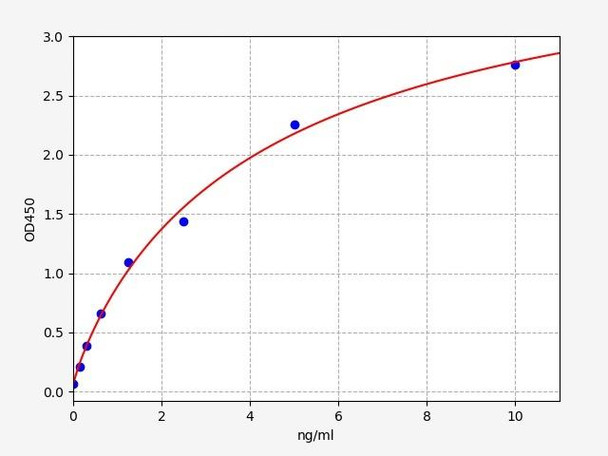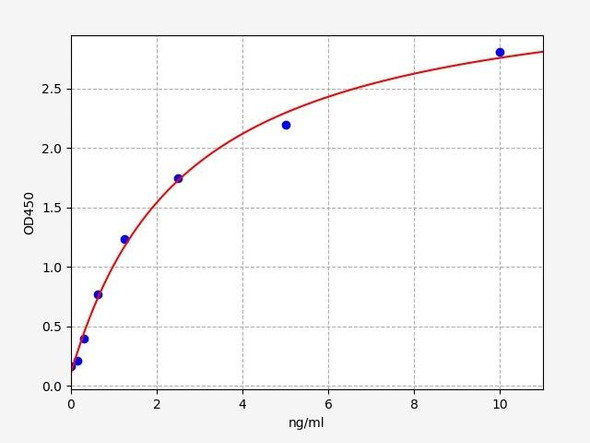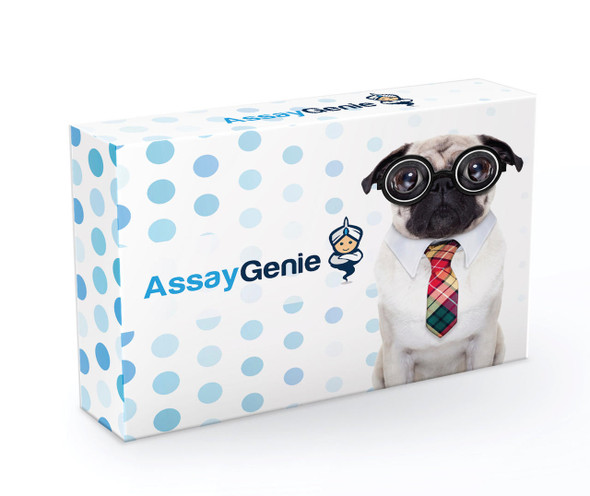Mouse HABP1/Hyaluronan Binding Protein 1 ELISA Kit (MOFI00880)
- SKU:
- MOFI00880
- Product Type:
- ELISA Kit
- Size:
- 96 Assays
- Uniprot:
- O35658
- Sensitivity:
- 0.094ng/ml
- Range:
- 0.156-10ng/ml
- ELISA Type:
- Sandwich
- Synonyms:
- HABP1, C1QBP, Hyaluronan Binding Protein 1, gC1qBP, gC1qR, SF2p32, p32, Glycoprotein gC1qBP, HABP1p33, GC1q-R protein, C1q globular domain-binding protein, gC1Q-R, Hyaluronan-binding protein 1, Mitochondrial matrix protein p32, splicing factor SF2-as
- Reactivity:
- Mouse
Description
Mouse HABP1/Hyaluronan Binding Protein 1 ELISA Kit
The Mouse HABP1 (Hyaluronan Binding Protein 1) ELISA Kit is designed for the precise measurement of HABP1 levels in mouse serum, plasma, and cell culture supernatants. This kit offers exceptional sensitivity and specificity, ensuring accurate and consistent results for various research purposes.HABP1 is a key protein that binds to hyaluronan, an important component of the extracellular matrix. It plays a crucial role in processes such as cell migration, proliferation, and tissue remodeling.
Dysregulation of HABP1 has been linked to various diseases, including cancer, inflammation, and fibrosis, making it a valuable biomarker for investigating these conditions and developing potential therapeutic interventions.Overall, the Mouse HABP1 ELISA Kit provides researchers with a reliable tool to study the role of HABP1 in different biological processes and disease states, allowing for the advancement of scientific knowledge and the development of targeted treatments.
| Product Name: | Mouse HABP1 / Hyaluronan Binding Protein 1 ELISA Kit |
| Product Code: | MOFI00880 |
| Size: | 96 Assays |
| Alias: | HABP1, C1QBP, Hyaluronan Binding Protein 1, gC1qBP, gC1qR, SF2p32, p32, Glycoprotein gC1qBP, HABP1p33, GC1q-R protein, C1q globular domain-binding protein, gC1Q-R, Hyaluronan-binding protein 1, Mitochondrial matrix protein p32, splicing factor SF2-associated protein |
| Detection Method: | Sandwich ELISA |
| Application: | This immunoassay kit allows for the in vitro quantitative determination of Mouse HABP1 concentrations in serum plasma and other biological fluids. |
| Sensitivity: | 0.094ng/ml |
| Range: | 0.156-10ng/ml |
| Storage: | 4°C for 6 months |
| Note: | For Research Use Only |
| Recovery: | Matrices listed below were spiked with certain level of Mouse HABP1 and the recovery rates were calculated by comparing the measured value to the expected amount of Mouse HABP1 in samples. | ||||||||||||||||
| |||||||||||||||||
| Linearity: | The linearity of the kit was assayed by testing samples spiked with appropriate concentration of Mouse HABP1 and their serial dilutions. The results were demonstrated by the percentage of calculated concentration to the expected. | ||||||||||||||||
| |||||||||||||||||
| Intra Assay: | CV <8% | ||||||||||||||||
| Inter Assay: | CV <10% |
| Component | Quantity | Storage |
| ELISA Microplate (Dismountable) | 8×12 strips | 4°C for 6 months |
| Lyophilized Standard | 2 | 4°C/-20°C |
| Sample/Standard Dilution Buffer | 20ml | 4°C |
| Biotin-labeled Antibody(Concentrated) | 120ul | 4°C (Protect from light) |
| Antibody Dilution Buffer | 10ml | 4°C |
| HRP-Streptavidin Conjugate(SABC) | 120ul | 4°C (Protect from light) |
| SABC Dilution Buffer | 10ml | 4°C |
| TMB Substrate | 10ml | 4°C (Protect from light) |
| Stop Solution | 10ml | 4°C |
| Wash Buffer(25X) | 30ml | 4°C |
| Plate Sealer | 5 | - |
Other materials and equipment required:
- Microplate reader with 450 nm wavelength filter
- Multichannel Pipette, Pipette, microcentrifuge tubes and disposable pipette tips
- Incubator
- Deionized or distilled water
- Absorbent paper
- Buffer resevoir
| Uniprot | O35658 |
| UniProt Protein Function: | C1QBP: a multifunctional and multicompartmental protein involved in inflammation and infection processes, ribosome biogenesis, regulation of apoptosis, transcriptional regulation and pre-mRNA splicing. Originally identified via its binding interactions with Splicing Factor (SF-2). Multiple, diverse binding partners of C1QBP were subsequently identified, including the globular heads of complement component C1q, hyaluronic acid, selected protein kinases, the tumor suppressor ARF, and multiple antigens of bacterial and viral origin. Overexpressed in a number of cancer cell types, and has been implicated in the Warburg effect, whereby cancer cells shift their metabolism from oxidative phosphorylation to glycolysis. Inhibits the Mitochondrial Permeability Transition (MPT) pore, possibly serving a protective function against damage from oxidative stress. Binding to C1q inhibits C1. In complex with cytokeratin-1/KRT1 is a high affinty receptor for kininogen-1/HMWK. The secreted form may enhance both extrinsic and intrinsic coagulation pathways. The cell surface form may require docking with transmembrane proteins for downstream signaling which might be specific for a cell-type or response. Belongs to the MAM33 family. |
| UniProt Protein Details: | Protein type:Mitochondrial; Motility/polarity/chemotaxis; Nucleolus; Receptor, misc. Chromosomal Location of Human Ortholog: 11 B4|11 43.21 cM Cellular Component: cell surface; cytoplasm; cytosol; extracellular region; extracellular space; membrane; mitochondrial matrix; mitochondrion; nucleus; plasma membrane Molecular Function:adrenergic receptor binding; complement component C1q binding; hyaluronic acid binding; kininogen binding; mRNA binding; protein binding; protein kinase C binding; transcription corepressor activity; transcription factor binding Biological Process: adaptive immune response; apoptosis; complement activation, classical pathway; immune system process; innate immune response; mature ribosome assembly; mRNA processing; negative regulation of defense response to virus; negative regulation of interferon-gamma production; negative regulation of interleukin-12 production; negative regulation of MDA-5 signaling pathway; negative regulation of nuclear mRNA splicing, via spliceosome; negative regulation of RIG-I signaling pathway; negative regulation of transcription from RNA polymerase II promoter; phosphoinositide 3-kinase cascade; positive regulation of apoptosis; positive regulation of cell adhesion; positive regulation of dendritic cell chemotaxis; positive regulation of neutrophil chemotaxis; positive regulation of protein kinase B signaling; positive regulation of substrate adhesion-dependent cell spreading; positive regulation of trophoblast cell migration; regulation of complement activation; regulation of transcription, DNA-templated; ribosome biogenesis; RNA splicing; transcription, DNA-dependent |
| UniProt Code: | O35658 |
| NCBI GenInfo Identifier: | 3334247 |
| NCBI Gene ID: | 12261 |
| NCBI Accession: | O35658.1 |
| UniProt Related Accession: | O35658 |
| Molecular Weight: | 31,013 Da |
| NCBI Full Name: | Complement component 1 Q subcomponent-binding protein, mitochondrial |
| NCBI Synonym Full Names: | complement component 1, q subcomponent binding protein |
| NCBI Official Symbol: | C1qbp |
| NCBI Official Synonym Symbols: | P32; HABP1; gC1qBP; AA407365; AA986492; D11Wsu182e |
| NCBI Protein Information: | complement component 1 Q subcomponent-binding protein, mitochondrial |
| UniProt Protein Name: | Complement component 1 Q subcomponent-binding protein, mitochondrial |
| UniProt Synonym Protein Names: | GC1q-R protein; Glycoprotein gC1qBP; C1qBP |
| UniProt Gene Name: | C1qbp |
*Note: Protocols are specific to each batch/lot. For the correct instructions please follow the protocol included in your kit.
| Step | Procedure |
| 1. | Set standard, test sample and control (zero) wells on the pre-coated plate respectively, and then, record their positions. It is recommended to measure each standard and sample in duplicate. Wash plate 2 times before adding standard, sample and control (zero) wells! |
| 2. | Aliquot 0.1ml standard solutions into the standard wells. |
| 3. | Add 0.1 ml of Sample / Standard dilution buffer into the control (zero) well. |
| 4. | Add 0.1 ml of properly diluted sample (Human serum, plasma, tissue homogenates and other biological fluids.) into test sample wells. |
| 5. | Seal the plate with a cover and incubate at 37 °C for 90 min. |
| 6. | Remove the cover and discard the plate content, clap the plate on the absorbent filter papers or other absorbent material. Do NOT let the wells completely dry at any time. Wash plate X2. |
| 7. | Add 0.1 ml of Biotin- detection antibody working solution into the above wells (standard, test sample & zero wells). Add the solution at the bottom of each well without touching the side wall. |
| 8. | Seal the plate with a cover and incubate at 37°C for 60 min. |
| 9. | Remove the cover, and wash plate 3 times with Wash buffer. Let wash buffer rest in wells for 1 min between each wash. |
| 10. | Add 0.1 ml of SABC working solution into each well, cover the plate and incubate at 37°C for 30 min. |
| 11. | Remove the cover and wash plate 5 times with Wash buffer, and each time let the wash buffer stay in the wells for 1-2 min. |
| 12. | Add 90 µL of TMB substrate into each well, cover the plate and incubate at 37°C in dark within 10-20 min. (Note: This incubation time is for reference use only, the optimal time should be determined by end user.) And the shades of blue can be seen in the first 3-4 wells (with most concentrated standard solutions), the other wells show no obvious color. |
| 13. | Add 50 µL of Stop solution into each well and mix thoroughly. The color changes into yellow immediately. |
| 14. | Read the O.D. absorbance at 450 nm in a microplate reader immediately after adding the stop solution. |
When carrying out an ELISA assay it is important to prepare your samples in order to achieve the best possible results. Below we have a list of procedures for the preparation of samples for different sample types.
| Sample Type | Protocol |
| Serum: | If using serum separator tubes, allow samples to clot for 30 minutes at room temperature. Centrifuge for 10 minutes at 1,000x g. Collect the serum fraction and assay promptly or aliquot and store the samples at -80°C. Avoid multiple freeze-thaw cycles. If serum separator tubes are not being used, allow samples to clot overnight at 2-8°C. Centrifuge for 10 minutes at 1,000x g. Remove serum and assay promptly or aliquot and store the samples at -80°C. Avoid multiple freeze-thaw cycles. |
| Plasma: | Collect plasma using EDTA or heparin as an anticoagulant. Centrifuge samples at 4°C for 15 mins at 1000 × g within 30 mins of collection. Collect the plasma fraction and assay promptly or aliquot and store the samples at -80°C. Avoid multiple freeze-thaw cycles. Note: Over haemolysed samples are not suitable for use with this kit. |
| Urine & Cerebrospinal Fluid: | Collect the urine (mid-stream) in a sterile container, centrifuge for 20 mins at 2000-3000 rpm. Remove supernatant and assay immediately. If any precipitation is detected, repeat the centrifugation step. A similar protocol can be used for cerebrospinal fluid. |
| Cell culture supernatant: | Collect the cell culture media by pipette, followed by centrifugation at 4°C for 20 mins at 1500 rpm. Collect the clear supernatant and assay immediately. |
| Cell lysates: | Solubilize cells in lysis buffer and allow to sit on ice for 30 minutes. Centrifuge tubes at 14,000 x g for 5 minutes to remove insoluble material. Aliquot the supernatant into a new tube and discard the remaining whole cell extract. Quantify total protein concentration using a total protein assay. Assay immediately or aliquot and store at ≤ -20°C. |
| Tissue homogenates: | The preparation of tissue homogenates will vary depending upon tissue type. Rinse tissue with 1X PBS to remove excess blood & homogenize in 20ml of 1X PBS (including protease inhibitors) and store overnight at ≤ -20°C. Two freeze-thaw cycles are required to break the cell membranes. To further disrupt the cell membranes you can sonicate the samples. Centrifuge homogenates for 5 mins at 5000xg. Remove the supernatant and assay immediately or aliquot and store at -20°C or -80°C. |
| Tissue lysates: | Rinse tissue with PBS, cut into 1-2 mm pieces, and homogenize with a tissue homogenizer in PBS. Add an equal volume of RIPA buffer containing protease inhibitors and lyse tissues at room temperature for 30 minutes with gentle agitation. Centrifuge to remove debris. Quantify total protein concentration using a total protein assay. Assay immediately or aliquot and store at ≤ -20 °C. |
| Breast Milk: | Collect milk samples and centrifuge at 10,000 x g for 60 min at 4°C. Aliquot the supernatant and assay. For long term use, store samples at -80°C. Minimize freeze/thaw cycles. |






